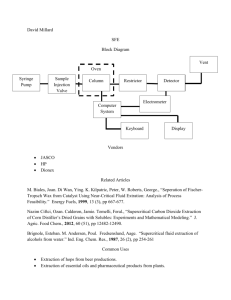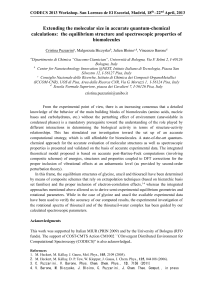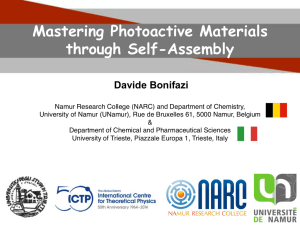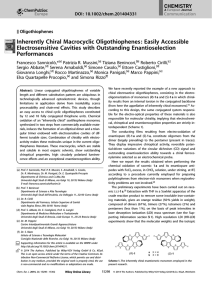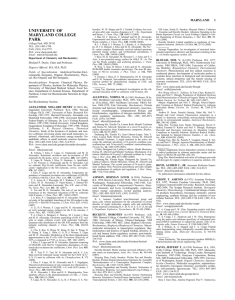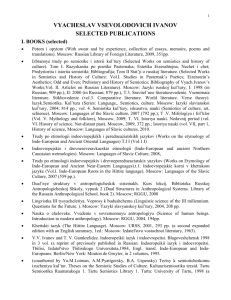YU-ISSN 0352-5139
advertisement
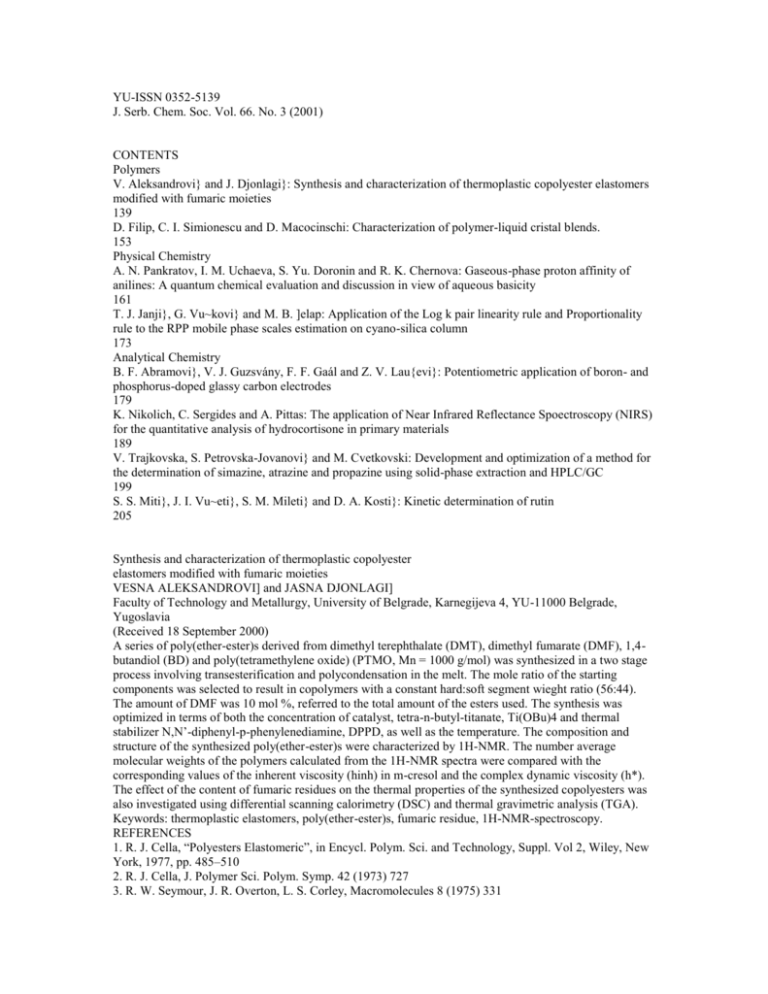
YU-ISSN 0352-5139
J. Serb. Chem. Soc. Vol. 66. No. 3 (2001)
CONTENTS
Polymers
V. Aleksandrovi} and J. Djonlagi}: Synthesis and characterization of thermoplastic copolyester elastomers
modified with fumaric moieties
139
D. Filip, C. I. Simionescu and D. Macocinschi: Characterization of polymer-liquid cristal blends.
153
Physical Chemistry
A. N. Pankratov, I. M. Uchaeva, S. Yu. Doronin and R. K. Chernova: Gaseous-phase proton affinity of
anilines: A quantum chemical evaluation and discussion in view of aqueous basicity
161
T. J. Janji}, G. Vu~kovi} and M. B. ]elap: Application of the Log k pair linearity rule and Proportionality
rule to the RPP mobile phase scales estimation on cyano-silica column
173
Analytical Chemistry
B. F. Abramovi}, V. J. Guzsvány, F. F. Gaál and Z. V. Lau{evi}: Potentiometric application of boron- and
phosphorus-doped glassy carbon electrodes
179
K. Nikolich, C. Sergides and A. Pittas: The application of Near Infrared Reflectance Spoectroscopy (NIRS)
for the quantitative analysis of hydrocortisone in primary materials
189
V. Trajkovska, S. Petrovska-Jovanovi} and M. Cvetkovski: Development and optimization of a method for
the determination of simazine, atrazine and propazine using solid-phase extraction and HPLC/GC
199
S. S. Miti}, J. I. Vu~eti}, S. M. Mileti} and D. A. Kosti}: Kinetic determination of rutin
205
Synthesis and characterization of thermoplastic copolyester
elastomers modified with fumaric moieties
VESNA ALEKSANDROVI] and JASNA DJONLAGI]
Faculty of Technology and Metallurgy, University of Belgrade, Karnegijeva 4, YU-11000 Belgrade,
Yugoslavia
(Received 18 September 2000)
A series of poly(ether-ester)s derived from dimethyl terephthalate (DMT), dimethyl fumarate (DMF), 1,4butandiol (BD) and poly(tetramethylene oxide) (PTMO, Mn = 1000 g/mol) was synthesized in a two stage
process involving transesterification and polycondensation in the melt. The mole ratio of the starting
components was selected to result in copolymers with a constant hard:soft segment wieght ratio (56:44).
The amount of DMF was 10 mol %, referred to the total amount of the esters used. The synthesis was
optimized in terms of both the concentration of catalyst, tetra-n-butyl-titanate, Ti(OBu)4 and thermal
stabilizer N,N’-diphenyl-p-phenylenediamine, DPPD, as well as the temperature. The composition and
structure of the synthesized poly(ether-ester)s were characterized by 1H-NMR. The number average
molecular weights of the polymers calculated from the 1H-NMR spectra were compared with the
corresponding values of the inherent viscosity (hinh) in m-cresol and the complex dynamic viscosity (h*).
The effect of the content of fumaric residues on the thermal properties of the synthesized copolyesters was
also investigated using differential scanning calorimetry (DSC) and thermal gravimetric analysis (TGA).
Keywords: thermoplastic elastomers, poly(ether-ester)s, fumaric residue, 1H-NMR-spectroscopy.
REFERENCES
1. R. J. Cella, “Polyesters Elastomeric”, in Encycl. Polym. Sci. and Technology, Suppl. Vol 2, Wiley, New
York, 1977, pp. 485–510
2. R. J. Cella, J. Polymer Sci. Polym. Symp. 42 (1973) 727
3. R. W. Seymour, J. R. Overton, L. S. Corley, Macromolecules 8 (1975) 331
4. G. Wegner, T. Fujii, W. Meyer, G. Lieser, Angew. Makromol. Chem. 74 (1978) 295
5. G. K. Hoeschele, W. K. Witsiepe, Makromol. Chem. 29/30 (1973) 267
6. W. K. Witsiepe, Segmented Thermoplastic Copolyesters Elastomers, U. S. Pat. 3, 766, 146 (1973)
7. W. K. Witsiepe, Segmented Thermoplastic Copolyesters, U. S. Pat. 3, 651, 014 (1972)
8. S. Fakirov, T. Gogeva, Macromol. Chem. 191 (1990) 603
9. S. Fakirov, T. Gogeva, Macromol. Chem. 191 (1990) 615
10. S. Fakirov, T. Gogeva, Macromol. Chem. 191 (1990) 2341
11. S. J. McCarty, G. F. Meijs, P. Gunatillake, J. Appl. Polym. Sci. 65 (1997) 1319
12. C. B. Quinn, J. Polym. Sci., Polym. Chem. Ed. 15 (1977) 2587
13. T. Gogeva, S. Fakirov, Makromol. Chem. 191 (1990) 2355
14. M. S. Jacovi}, B. Dunji}, J. Djonlagi}, N. Spassky, M. Sepulchre, M. O. Sepulchre, Polym. Bull. 28
(1992) 621
15. J. Djonlagi}, V. Aleksandrovi}, B. Dunji}, R. Jovanovi}, Conference Proceedings of Meeting “World
of Polymers” Beoplast 97, Beograd, 22–23 September, 1997, p. 32
16. G. B. Kharas, M. Kamenetsky, J. Simantirakis, K. C. Beinlich, A. M. T. Rizzo, G. A. Caywood, K.
Watson, J. Appl. Polym. Sci. 66 (1997) 1123
18. J. P. Runt, “Crystallinity determination”, in Encycl. Polym. Sci. Eng., Vol 4, Wiley, New York, 1986,
pp. 482–519.
Characterization of polymer-liquid crystal blends
DANIELA FILIP, CRISTOFOR I. SIMIONESCU and DOINA MACOCINSCHI
“Petru Poni” Institute of Macromolecular Chemistry, Aleea Gr. Ghica Voda 41 A, 6600 Jassy,
Romania
(Received 14 August, revised 6 December 2000)
Blends of semi-crystalline polymers (polyethylene adipate and two poly(ester-urethane)s) with liquid
crystal cholesteryl palmitate with different compositions were prepared by solution casting. One of the
poly(ester-urethane)s was based on 2,4-tolylene diisocyanate (TDI) and the other one on 4,4’diphenylmethane diisocyanate (MDI). The miscibility and phase transition were investigated over the
whole range of concentration by differential scanning calorimetry and polarizing optical microscopy.
Keywords: liquid crystal, blend, polyester, poly(ester-urethane).
REFERENCES
1. J. R. S. Rodrigues, A. Kaito, V. Soldi, A. T. N. Pires, Polym. Int. 46 (1998) 138
2. C. C. Riccardi, J. Borrajo, R. J. J. Williams, H. M. Siddigi, M. Dumon, J. P. Pascault, Macromolecules
31 (1998) 1124
3. Z. Q. Lin, H. D. Zhang, Y. L. Yang, Macromol. Theory Simul. 6 (1997) 1153
4. M. Pracella, B. Bresci, Mol. Cryst. Liq. Cryst. Sci. Technol., Sect A 266 (1995) 23
5. G. M. Russell, B. J. A. Paterson, C. T. Imrie, S. K. Heeks, Chem. Mater. 7 (1995) 2185
6. H-K. Jeong, H. Kikuchi, T. Kajiyama, New Polym. Mater. 5 (1998) 103
7. C. Carfagna, E. Amendola, M. Giamberini, H. Hakemi, S. Pane, Polym. Int. 44 (1997) 465
8. L. Carpaneto, A. Ristango, P. Stagnaro, B. Valenti, Mol. Cryst. Liq. Cryst. Sci. Technol., Sect. A 290
(1996) 213
9. C-L. Lin, L-C. Chien, Macromol. Rapid Commun. 16 (1995) 869
10. A. K. Kalkar, A. A. Bhalwandar, Polym. Sci. 2 (1994_) 573
11. A. K. Kalkar, V. V. Kunte, A. A. Deshpande, Macromol. New Front., Proc.IUPAC Int. Symp. Adv.
Polym. Sci. Technol, 1 (1998) 239
12. P. J. Flory, Principles of Polymer Chemistry, Cornell University Press, Ithaca, 1953, p. 568
13. S-C. Peng, J-W. Yu, S-N. Lee, J. Polym. Sci. B: Polym. Phys. 35 (1997) 1373
14. D. Filip, C. I. Simionescu, D. Macocinschi, I. Parashiv, (submitted).
Gaseous-phase proton affinity of anilines: A quantum chemical evaluation and discussion in view of
aqueous basicity
ALEXEI N. PANKRATOV, INNA M. UCHAEVA, SERGEI YU. DORONIN and
RIMMA K. CHERNOVA
Department of Chemistry, N. G. Chernyshevskii Saratov State University, 83 Astrakhanskaya Street,
Saratov 410026, Russia
(Received 15 September, revised 4 December 2000)
Using the PM3 method, enthalpies and free energies of the gaseous-phase proton affinity (PA) have been
computed for aniline and 62 of its derivatives with different kinds of electron-donor and electron-acceptor
substitution in the aromatic ring and at the nitrogen atom. Linear correlations of the type pKa vs. PA have
been found. Deviations of the data for ortho substituted anilines from the above relationships was discussed
in view of possible hydrophobic hydration of the molecular fragments ajacent to the protonation centre.
Linear dependeces Pexper = bPtheor (where P is standard entropy, heat or Gibbs energy of formation, first
ionization potential, molecular dipole moment) were found.
Keywords: anilines, proton affinity, basicity, quantum chemical computation, theory-experiment
correlation, hydrophobic hydration.
REFERENCES
1. R. De Kock, C. Jasperse, Inorg. Chem. 22 (1983) 3839
2. S. Olivella, F. Urpi, J. Vilarrasa, J. Comput. Chem. 5 (1984) 230
3. D. R. Stull, E. F. Westrum, G. C. Sinke, The Chemical Thermodynamics of Organic Compounds, Wiley
Inc., New York, London, Sydney, Toronto, 1969. Russian Edition: Mir, Moscow, 1971, p. 807, Suppl.
4. V. A. Kireev, Methods of Practical Calculations in Thermodynamics of Chemical Reactions (in
Russian), Khimiya, Moscow, 1975, p. 536
5. M. Kh. Karapet'yants, M. L. Karapet'yants, Basic Thermodynamic Constants of Inorganic and Organic
Substances (in Russian), Khimiya, Moscow, 1968, p. 472
6. A. Albert, E. P. Serjeant, Ionization Constants of Acids and Bases, Chapman and Hall, London, 1971, p.
179
7. A. J. Gordon, R. A. Ford, The Chemist's Companion. A Handbook of Practical Data, Techniques, and
References, A Wiley-Interscience Publication, Wiley, New York, London, Sydney, Toronto, 1972, Russian
Edition: Mir, Moscow, 1976, p. 543
8. P. Sykes, A Guidebook to Mechanism in Organic Chemistry, Longman Scientific & Tecnical, London,
Wiley, New York, 1986. Russian Edition: Reaction Mechanisms in Organic Chemistry (in Russian), Mir,
Moscow, 1991, p. 448
9. A. S. Dneprovskii, T. I. Temnikova, Theoretical Bases of Organic Chemistry (in Russian), Khimiya,
Leningrad, 1991, p. 560
10. R. Graglia, E. Pramauro, E. Pelizzetti, Annali di Chemica 74 (1984) 41
11. J. J. P. Stewart, J. Comput. Chem. 10 (1989) 209, 221
12. J. J. Stewart, MOPAC, A Semi-Empirical Molecular Orbital Program, QCPE, 1983, Program No. 455
13. T. Clark, A Handbook of Computational Chemistry. A Practical Guide to Chemical Structure and
Energy, A Wiley Interscience Publication, Wiley, New York, Chichester, Brisbane, Toronto, Singapore,
1985. Russian Edition: Mir, Moscow, 1990, p. 383
14. J. E. Dennis, R. B. Schnabel, Numerical Methods for Unconstrained Optimization and Nonlinear
Equations, Prentice-Hall, Inc., Englewood Cliffs, New Jersey 07632, 1983. Russian Edition: Mir, Moscow,
1988, p. 440
15. W. Thiel, J. Mol. Struct. Theochem 163 (1988) 415
16. U. Burkert, N. L. Allinger, Molecular Mechanics, ACS Monograph 177, American Chemical Society,
Washington, D. C. 1982. Russian Edition: Mir, Moscow 1986, p. 364
17. A. N. Pankratov, A. E. Shchavlev, J. Mol. Struct. Theochem. 392 (1997) 137
18. A. N. Pankratov, J. Mol. Struct. Theochem. 453 (1998) 7
19. A. N. Pankratov, Afinidad 56 (1999) 257
20. A. N. Pankratov, A. E. Shchavlev, Canad. J. Chem. 77 (1999) 2053
21. A. N. Pankratov, J. Serb. Chem. Soc. 65 (2000) 1
22. A. N. Pankratov, I. M. Uchaeva, J. Mol. Struct. Theochem. 498 (2000) 247
23. A. N. Pankratov, Zn. Strukt. Khimii 41 (2000) 696
24. A. N. Pankratov, A. E. Shchavlev, Monatsh. Chem. 129 (1998) 1007
25. A. N. Pankratov, A. E. Shchavlev, Zh. Strukt. Khimii 40 (1999) 1059
26. L. V. Gurvich, G. V. Karachevtsev, V. N. Kondrat'ev, Yu. A. Lebedev, V. A. Medvedev, V. K.
Potapov, Yu. S. Khodeev, Energies of Chemical Bonds Splitting. Ionization Potentials and Electron
Affinity (in Russian), V. N. Kondrat'ev, Editor-in-Chief, Nauka, Moscow, 1974, p. 351
27. M. D. Newton, J. Chem. Phys. 48 (1968) 2825
28. O. A. Osipov, V. I. Minkin, A. D. Garnovsky, Reference Book on Dipole Moments (in Russian),
Vysshaya Shkola, Moscow, 1971, p. 416
29. Yu. I. Naberukhin, V. A. Luchnikov, G. G. Malenkov, E. A. Zheligovskaya, Zh. Strukt. Khimii 38
(1997) 713
30. A. N. Pankratov, O. A. Bilenko, S. P. Mushtakova, Afinidad 57 (2000) p. 201
31. A. N. Pankratov, S. P. Mushtakova, Zh. Anal. Khimii 55 (2000) 799
32. R. P. Bell, The Proton in Chemistry, Chapman and Hall, London, 1973. Russian Edition: Mir, Moscow,
1977, p. 384
33. O. Ya. Samoilov, Zh. Fiz. Khimii 52 (1978) 1857
34. S. B. Savvin, R. K. Chernova, S. N. Shtykov, Surface-Active Substances (in Russian), E. A.
Ostroumov, Responsible Editor, Nauka, Moscow, 1991, p. 251
35. S. N. Shtykov, V. G. Amelin, N. N. Sorokin, R. K. Chenova, Zh. Fiz. Khimii 60 (1986) 345.
Application of the Log k pair linearity rule and Proportionality rule to the RPP mobile phase scales
estimation on cyano-silica column
TOMISLAV J. JANJI], GORDANA VU^KOVI]*# and MILENKO B. ]ELAP#
Faculty of Chemistry, University of Belgrade, P. O. Box 158, YU-11001 Belgrade, Yugoslavia
(Received 13 November 2000)
On the basis of literature-reported log k values, the Log k pair linearity rule and the Proportionality rule
were found to be also valid in the case of cyano-silica sorbent, when methanol, acetonitrile or propane-2-ol
were used as modifiers. The RPP scales, reflecting the solvent strength, are in good linear relationship with
the experimentally determined log k values. Furthermore, in the case of methanol and acetonitrile, the
linear dependence: log k = f(mol % of modifier) was also established. In the function obtained in a such
way, the intercept and the slope exhibit an approximate linear dependence. Finally, in the case of methanol,
the experimentally obtained log k values are in a satisfactory agreement with the values calculated by the
above equation.
Keywords: column chromatography, cyano-silica sorbent, Log k pair linearity rule, Proportionality rule,
RPP scale.
REFERENCES
1. T. J. Janji}, G. Vu~kovi}, M. B. ]elap, Chromatographia 42 (1996) 675
2. T. J. Janji}, G. Vu~kovi}, M. B. ]elap, J. Serb. Chem. Soc. 62 (1997) 495
3., T. J. Janji}, G. Vu~kovi}, M. B. ]elap, J. Serb. Chem. Soc. 62 (1997) 897
4., T. J. Janji}, G. Vu~kovi}, M. B. ]elap, J. Serb. Chem. Soc. 63 (1998) 519
5., T. J. Janji}, G. Vu~kovi}, M. B. ]elap, J. Serb. Chem. Soc. 65 (2000) 733
6. D. S. Seibert, C. F. Pool, Chromatographia 41 (1995) 51
7. D. S. Seibert, C. F. Pool, M. H. Abraham, Analyst 121 (1996) 511
8. T. J. Janji}, G. Vu~kovi}, M. B. ]elap, J. Planar Chromatogr. 10 (2000) 135.
Potentiometric application of boron- and phosphorus-doped glassy carbon electrodes
BILJANA F. ABRAMOVI]1#, VALÉRIA J. GUZSVÁNY1, FERENC F. GAÁL1 and
ZORAN V. LAU[EVI]2
1Institute of Chemistry, Faculty of Science, Trg D. Obradovi}a 3, YU-21000 Novi Sad and 2Vin~a
Institute of Nuclear Science, P. O. Box 522, YU-11001 Belgrade, Yugoslavia
(Received 19 September, revised 5 December 2000)
A comparative study was carried out of the potentiometric application of boron- and phosphorus-doped and
undoped glassy carbon samples prepared at the same heat treatment temperature (HTT 1000 ºC). The
electrochemical activities of the obtained electrode materials were investigated on the example of
argentometric titrations. It was found that the electrochemical behaviour of the doped glassy carbon
samples are very similar to a Sigri (undoped) glassy carbon sample (HTT 2400 ºC). The experiments
showed that the potentiometric response depends on the polarization mode, the nature of the sample, the
pretreatment of the electrode surface, and the nature of the supporting electrolyte. The amounts of iodide,
bromide, and of chloride were determined to be 1.27 mg, 0.80 mg and 0.54 mg, respectively, with a
maximum relative standard deviation of less than 1.1 %. The obtained results are in good agreement with
the results of comparative potentiometric titrations using a silver indicator electrode. The titration method
was applied to the indirect determination of pyridoxine hydrochloride, i.e., vitamin B6.
Keywords: boron- and phosphorus-doped glassy carbon electrodes; potentiometric titration of halides;
determination of vitamin B6.
REFERENCES
1. H. D. Hutton, W. Huang, D. C. Alsmeyer, J. Kometani, R. L. McCreery, T. X. Neenan, M. R. Callstrom,
Chem. Mater. 5 (1993) 1110
2. M. L. Pocard, D. C. Alsmeyer, R. L. McCreery, T. X. Neenan, M. R. Callstrom, J. Mater. Chem. 2
(1992) 771
3. T. \urki}, A. Peri}, M. Lau{evi}, A. Dekanski, O. Ne{kovi}, M. Veljkovi}, Z. Lau{evi}, Carbon 35
(1997) 1567
4. F. F. Gaál, B. F. Abramovi}, Talanta 27 (1980) 733
5. F. F. Gaál, B. F. Abramovi}, Mikrochim. Acta [ Wien ] I (1982) 465
6. B. F. Abramovi}, F. F. Gaál, R. I. Cservenák, A. Gy. Varga, Microchem. J. 30 (1984) 162
7. B. F. Abramovi}, F. F. Gaál, M. M. Marinkovi}, Acta Pharm. Jugosl. 39 (1989) 129
8. B. Abramovi}, F. Gaál, K. Horváth, Glasnik na hemi~arite i tehnolozite na Makedonija 7 (1989) 293
9. B. F. Abramovi}, M. M. Marinkovi}, F. F. Gaál, Analyst 115 (1990) 79
10. B. F. Abramovi}, F. F. Gaál, S. D. Cvetkovi}, Talanta 39 (1992) 511
11. Lj. S. Jovanovi}, N. J. Evi}, L. J. Bjelica, B. F. Abramovi}, F. F. Gaál, N. L. Rehák, Monatsh. Chem.
123 (1992) 1071
12. B. F. Abramovi}, K. S. Horváth, F. F. Gaál, O. P. Gaál, Microchem. J. 48 (1993) 137
13. B. F. Abramovi}, F. F. Gaál, K. S. Horváth, B. K. Abramovi}, J. Serb. Chem. Soc. 59 (1994) 167
14. B. F. Abramovi}, S. D. Tepav~evi}, B. K. Abramovi}, F. F. Gaál, Analyst 121 (1996) 425
15. Farmakopeja SFRJ, Ph. Jug. IV, Federal Health Protection Institute, Belgrade, 1984, vol. II, p. 910.
The application of Near Infrared Reflectance Spectroscopy (NIRS) for the quantitative analysis of
hydrocortisone in
primary materials
K. NIKOLICH, C. SERGIDES and A. PITTAS
Medochemie Ltd, Limassol, Cyprus
(Received 15 May, revised 5 December 2000)
Near Infrared Reflectance Spectroscopy (NIRS), coupled with fiber optic probes, has been shown to be a
quick and reliable analytical tool for quality assurance and quality control in the pharmaceutical industry,
both for verifications of raw materials and quantification of the active ingredients in final products. In this
paper, a typical pharmaceutical product, hydrocortisone sodium succinate, is used as an example for the
application of NIR spectroscopy for quality control. In order to develop an NIRS method with higher
precision and accuracy than the official UV/VIS spectroscopic method (BP '99), 19 samples, taken from
one year’s production and several prepared in the laboratory, having a hydrocortisone sodium succinate
concentration in the range from 89.05 % to 95.83 %, were analysed by NIR and UV/VIS spectroscopy.
Three frequency ranges: 5939.73–5627.32 cm-1; 4863.64 – 4574.36 cm-1; 4308.23–4200.24 cm-1, with the
best positive correlation between the changes in the spectral and concentration data, were chosen. The
validity of the developed NIRS chemometric method for the determination of the hydrocortisone sodium
succinate concentration, constructed by the partial least squares (PLS) regression technique, is discussed. A
correlation coefficient of 0.9758 and a standard error of cross validation (RMSECV) of 1.06 % were found
between the UV/VIS and the NIR spectroscopic results of the hydrocortisone sodium succinate
concentration in the samples.
Keywords: FTNIRS, quantitative analysis, hydrocortisone.
REFERENCES
1. P. Kubelka, F. Munk, Z. Tech. Phys. 12 (1931) 593
2. P. Kubelka, J. Opp. Soc. Am. 38 (1948) 448
3. D. M. Haaland, E. V. Thomas, Anal. Chem. 60 (1998) 1193
4. G. Schwedt, Taschenatlas der Analytik, Thieme Press, Stuttgart, 1st ed: p. 110 ff (1992)
5. P. Geladi, B. R. Kowalski, Anal. Chim. Acta 1 (1986) 185
6. K. R. Beebe, B. Kowalski, Anal. Chem. 59 (1987) 1007A
7. H. Martens, T. Naes, Multivariate Calibration, Wiley, New York, 1989, Chapater 3.5
8. S. D. Brown, Appl. Spectrosc. 49 (1995) 14A
9. S. Lonardi, R. Viviani, L. Mosconi, M. Bernuzzi, P. Corty, E. Dreassi, C. Murratzy, G. Corbini,
Pharmac. & Biomed. Anal. 7 (1989) 303
10. Multivariate Calibration, Bruker Optics, 2nd revised ed: (1999) p. 3.
Development and optimization of a method for the
determination of simazine, atrazine and propazine using solid-phase extraction and HPLC/GC
VERA TRAJKOVSKA, SIMKA PETROVSKA-JOVANOVI] and MIRKO CVETKOVSKI*
Institute of Chemistry, Faculty of Science, "St. Cyril and Methodius University", P.O. Box 162, 91000
Skopje, Macedonia and *Republic Institute of Hydrometeorology, Skupi bb, 91000 Skopje, Macedonia
(Received 18 May, revised 25 December 2000)
A solid-phase extraction (SPE) method, coupled with HPLC/DAD and GC/FID analysis has been
developed for the simultaneous determination of simazine, atrazine and propazine in water samples. The
compounds of interest were enriched on Envi-carb SPE tubes. The recoveries for simazine, atrazine and
propazine from spiked Nanopure water were 101± 5.6 %, 99 ± 4.9 % and 96 ± 5.7 %, respectively. The
detection limits were 4.00, 8.00 and 10.00 ng absolute sample mass in the column for simazine, atrazine
and propazine, respectively. Standard curve r2 values of 0.9828–0.9988 for the analyzed compounds were
consistently obtained.
Keywords: determination, solid-phase extraction, HPLC/GC, atrazine, simazine, propazine.
REFERENCES
1. D. Barcelo, Analyst 116 (1991) 681
2. R. E. Clement, F. I. Onuska, G. A. Eiceman, H. H. Hill, Anal. Chem. 60 (1988) 279R
3. D. Barcelo, Chromatographia 25 (1988) 928
4. M. W. Brooks, J. Jenkins, M. Jeminez, T. Quinn, J. M. Clark, Analyst 114 (1989) 405
5. Applications Bibliography Sample Preparation Products, Varian, Harbor City, Ca, 1992
6. G. H. Tan, Analyst 117 (1992) 1129
7. O. Evans, B. J. Jacobs, A. L. Cohen, Analyst 116 (1991) 15
8. A. Kraut-Vass, J. Thoma, J. Chromatogr. 538 (1991) 233
9. E. M. Thurman, D. A. Goolsby, M. T. Meyer, D. W. Koplin, Environ. Sci. Technol. 25 (1991) 1794
10. W. E. Periera, C. E. Rostad, Environ. Sci. Technol. 24 (1990) 1400
11. J. C. Molto, Y. Pico, G. Font, J. Manes, J. Chromatogr. 555 (1991) 137
12. H. Bagheri, J. J. Vreuls, R. T. Ghijsen, U. A. Th. Brinkman, Chromatographia 34 (1992) 5
13. G. Duran, D. Barcelo, J. Chromatogr. 502 (1990) 275
14. W. Schusller, Chromatographia 27 (1989) 431
15. M. S. Mills, E. M. Thurman, J. Chromatogr. 629 (1993) 11
16. S. Chiron, S. Dupas, P. Scribe, D. Barcelo, J. Chromatogr. 665 (1994) 295
17. D. A. Skoog, D. M. West, F. J. Holler, Analytical Chemistry, Saunders College Publishing,
Philadelphia, 1994, p. 91.
Kinetic determination of rutin
S. S. MITI]a, J. I. VU^ETI]b, S. M. MILETI]a and D. A. KOSTI]a
aDepartment of Chemistry, University of Ni{, ]irila i Metodija 2, YU-18000 Ni{, and bFaculty of
Chemistry, University of Belgrade, YU-11000 Belgrade, Yugoslavia
(Received 18 October, revised 18 December 2000)
A kinetic method is described for the determination of rutin based on its inhibitory effect on the Fe(II)-AA
catalysis of the oxidation of C6H5COONa with hydrogen peroxide. Detection limit of this method is 0.16
ng cm-3. The relative error ranges between 0.9 to 9.8 % for the concentration interval 0.82 ng cm-3 to 8.2
ng cm-3. Kinetic equations are proposed for the investigated process. The effects of certain foreign ions
upon the reaction rate were determined for the assessment of the selectivity of the method.
Keywords: kinetic method, rutin, determination.
REFERENCES
1. J. B. Fairbairn, The Pharmacology of Plant Phenols, Academic Press, London and New York, 1959, p.
253
2. S. M. Tzouwara-Karayanni, S. M. Philiannos, Microchim. J. 27 (1982) 155
3. T. A. Vasilchuck, A. T. Pilipenko, A. I. Volkova, Ukr. Khim. Zh. 51 (1985) 278
4. S. M. Tzouwara-Karayanni, S. M. Philiannos, Microchim. Acta II (1983) 151
5. M. Careri, M. Elviri, A. Mangi, M. Mush, J. Chromatogr. A. (2000) 1-2, 449
6. A. J. Si~ev, V. G. Isak, Gomogenii kataliz soedineniami zheleza, [tiinca Ki{inev, 1988, p. 160
7. K. B. Yatsimirskii, Kinetic Methods of Analysis, Pergamon, Oxford, U.K., 1966, p. 138
8. D. Perez-Bendito, S. Silva, Kinetic Methods in Analytical Chemistry, Ellis Horwood, 1988, p. 256
9. G. F. Kirkbright, Talanta 13 (1966) 1.
